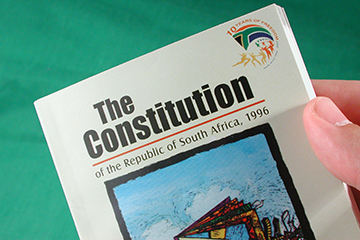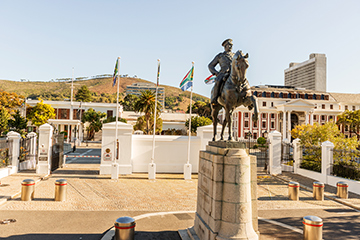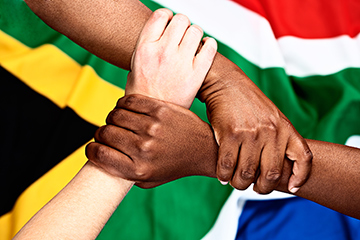The Government of South Africa: Overview
The National Government of South Africa is comprised of Parliament, Cabinet and various Ministries. These components carry out functions as outlined in the Constitution and in legislation enacted by Parliament.
- The National Government Ministries
- The Constitution of the Republic of South Africa
- The South African Parliament
- Cabinet
- Overview of South Africa
- Official Languages
- Population
- The National Coat of Arms
The National Government Departments

The Departments that make up the national administration are charged with implementing legislation and providing services to the public.
Agriculture
Land Reform and Rural Development
Basic Education
Communications and Digital Technologies
Co-operative Governance and Traditional Affairs
Defence and Military Veterans
Electricity and Energy
Science, Technology and Innovation
Employment and Labour
Finance
Forestry, Fisheries and Environment
Health
Higher Education and Training
Home Affairs
Human Settlements
International Relations and Cooperation
Justice and Constitutional Development
Mineral and Petroleum Resources
Planning, Monitoring and Evaluation
Police Service
Public Service and Administration
Public Works and Infrastructure
Small Business Development
Social Development
Sport, Arts and Culture
Tourism
Trade, Industry and Competition
Transport
Water and Sanitation
Women, Youth and Persons with Disabilities
Correctional Services
Government Communication and Information System (GCIS)
Independent Police Investigative Directorate (IPID)
National School of Government
National Planning Commission
National Treasury
Office of the Chief Justice
Public Service Commission
SA Police Service
SA Revenue Service
Statistics South Africa
The Presidency
The Constitution of the Republic of South Africa

The Constitution of the Republic of South Africa, 1996 (Act 108 of 1996) came into effect on 4 February 1997. This is the highest law in South Africa and no other law or government action can overrule the Constitution or be in conflict with it.
South Africa's Constitution is one of the most progressive in the world and is based on the values of dignity, equality and freedom.
Chapter 2 of the Constitution contains the Bill of Rights.
The South African Parliament
The South African Parliament is responsible for creating and amending the countries laws in accordance with the
Constitution. It consists of two parts, the National Assembly and the National Council of Provinces (NCOP).
The National Assembly consists of 400 elected representatives who meet at the Houses of Parliament in Cape Town, to debate issues and create legislation.
The National Council of Provinces consists of 54 permanent members and 36 special delegates representing the nine provinces. The NCOP represents provincial interests in the national sphere of government.
Cabinet

The executive arm of national government is headed up by the Cabinet which consists of the President, the Deputy President and various Ministers appointed by the President from the National Assembly. The President also determines which functions each of the Ministers will perform.
The Cabinet members currently are:
- President: Mr Matamela Cyril Ramaphosa
- Deputy President: Mr Paul Mashatile
- Agriculture: Mr John Steenhuisen
- Land Reform and Rural Development: Mr Mzwanele Nyhontsho
- Basic Education: Ms Siviwe Gwarube
- Communications and Digital Technologies: Mr Solly Malatsi
- Co-operative Governance and Traditional Affairs: Mr Velenkosini Hlabisa
- Defence and Military Veterans: Mrs Angie Motshekga
- Electricity and Energy: Mr Kgosientsho Ramokgopa
- Science, Technology and Innovation: Mr Blade Nzimande
- Employment and Labour: Ms Nomakhosazana Meth
- Finance: Mr Enoch Godongwana
- Forestry, Fisheries and Environment: Mr Dion George
- Health: Dr Aaron Motsoaledi
- Higher Education and Training: Dr Nobuhle Nkabane
- Home Affairs: Mr Leon Schreiber
- Human Settlements: Ms Mmamoloko Kubayi
- International Relations and Cooperation: Mr Ronald Lamola
- Justice and Constitutional Development: Ms Thembi Nkadimeng
- Mineral and Petroleum Resources: Mr Gwede Mantashe
- Planning, Monitoring and Evaluation: Ms Maropene Ramokgopa
- Police: Mr Senzo Mchunu
- Precidency: Ms Khumbudzo Ntshavheni
- Public Service and Administration: Mr Mzamo Buthelezi
- Public Works and Infrastructure: Mr Dean Macpherson
- Small Business Development: Ms Stella Ndabeni-Abrahams
- Social Development: Ms Sisi Tolashe
- Sport, Arts and Culture: Mr Gayton Mckenzie
- Tourism: Ms Patricia De Lille
- Trade, Industry and Competition: Mr Parks Tau
- Transport: Ms Barbara Creecy
- Water and Sanitation: Ms Pemmy Majodina
- Women, Youth and Persons with Disabilities: Ms Sindisiwe Chikunga
- Correctional Services: Mr Pieter Groenewald
Overview of South Africa

South Africa consists of 1 219 090 km² at the southern-most tip of Africa. There is a population of approximately 51.8 million people (Statistics South Africa, Census 2011).
South Africa is characterised by the diversity of its people in terms of race, culture and religion. This is reflected in the 11 national languages protected by the South African Constitution.
The country is divided into nine provinces, each with its own provincial parliament and administration. The nine provinces are:
- Western Cape
- Eastern Cape
- Free State
- Gauteng
- KwaZulu-Natal
- Limpopo (formerly Northern Province)
- Mpumalanga
- Northern Cape
- North West
Official languages
- English
- isiZulu
- isiXhosa
- isiNdebele
- Afrikaans
- siSwati
- Sepedi
- Sesotho
- Setswana
- Tshivenda
- Xitsonga
Population
Total: 60,14 million (2021)
Male: 29,39 million (48,9%)
Female: 30,75 million (51,1%)
For more information on South Africa, consult the South Africa Yearbook.
A national Coat of Arms, or state emblem, is the highest visual symbol of the State. The Coat of Arms is also a central part of the Great Seal, traditionally considered to be the highest emblem of the State. Absolute authority is given to every document with an impression of the Great Seal on it, which means it has been approved by the President of South Africa.
South Africa’s Coat of Arms was launched on Freedom Day, 27 April 2000. The change reflected government's aim to highlight the democratic change in South Africa and a new sense of patriotism.
The design /symbols of the Coat of Arms consist of:
- The motto

- The ears of wheat
- Elephant tusks
- The shield
- The human figures
- The spear and knobkierie
- The protea
- The secretary bird
- The rising sun
Read more about the National Coat of Arms and what it represents.
WEBSITE: www.gov.za


